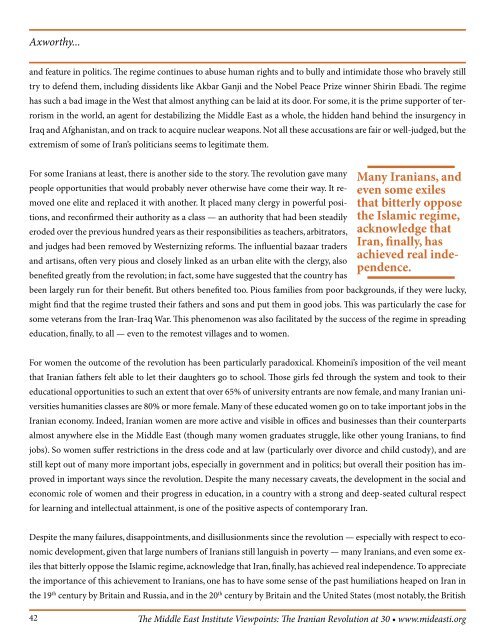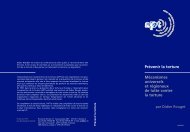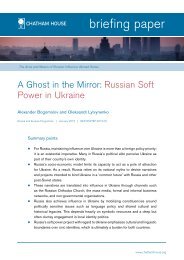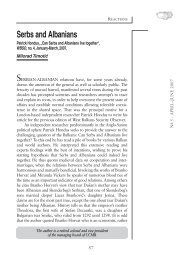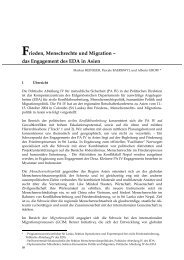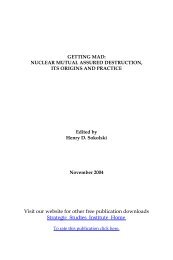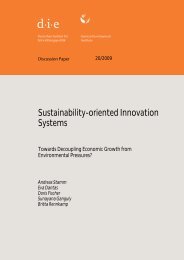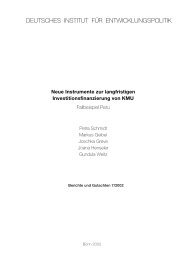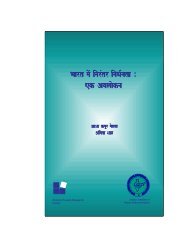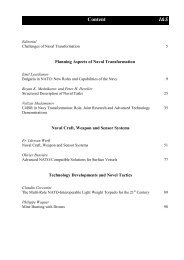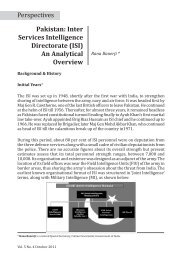The Iranian Revolution at 30
The Iranian Revolution at 30
The Iranian Revolution at 30
You also want an ePaper? Increase the reach of your titles
YUMPU automatically turns print PDFs into web optimized ePapers that Google loves.
Axworthy...<br />
and fe<strong>at</strong>ure in politics. <strong>The</strong> regime continues to abuse human rights and to bully and intimid<strong>at</strong>e those who bravely still<br />
try to defend them, including dissidents like Akbar Ganji and the Nobel Peace Prize winner Shirin Ebadi. <strong>The</strong> regime<br />
has such a bad image in the West th<strong>at</strong> almost anything can be laid <strong>at</strong> its door. For some, it is the prime supporter of terrorism<br />
in the world, an agent for destabilizing the Middle East as a whole, the hidden hand behind the insurgency in<br />
Iraq and Afghanistan, and on track to acquire nuclear weapons. Not all these accus<strong>at</strong>ions are fair or well-judged, but the<br />
extremism of some of Iran’s politicians seems to legitim<strong>at</strong>e them.<br />
Many <strong>Iranian</strong>s, and<br />
even some exiles<br />
th<strong>at</strong> bitterly oppose<br />
the Islamic regime,<br />
acknowledge th<strong>at</strong><br />
Iran, finally, has<br />
achieved real independence.<br />
For some <strong>Iranian</strong>s <strong>at</strong> least, there is another side to the story. <strong>The</strong> revolution gave many<br />
people opportunities th<strong>at</strong> would probably never otherwise have come their way. It removed<br />
one elite and replaced it with another. It placed many clergy in powerful positions,<br />
and reconfirmed their authority as a class — an authority th<strong>at</strong> had been steadily<br />
eroded over the previous hundred years as their responsibilities as teachers, arbitr<strong>at</strong>ors,<br />
and judges had been removed by Westernizing reforms. <strong>The</strong> influential bazaar traders<br />
and artisans, often very pious and closely linked as an urban elite with the clergy, also<br />
benefited gre<strong>at</strong>ly from the revolution; in fact, some have suggested th<strong>at</strong> the country has<br />
been largely run for their benefit. But others benefited too. Pious families from poor backgrounds, if they were lucky,<br />
might find th<strong>at</strong> the regime trusted their f<strong>at</strong>hers and sons and put them in good jobs. This was particularly the case for<br />
some veterans from the Iran-Iraq War. This phenomenon was also facilit<strong>at</strong>ed by the success of the regime in spreading<br />
educ<strong>at</strong>ion, finally, to all — even to the remotest villages and to women.<br />
For women the outcome of the revolution has been particularly paradoxical. Khomeini’s imposition of the veil meant<br />
th<strong>at</strong> <strong>Iranian</strong> f<strong>at</strong>hers felt able to let their daughters go to school. Those girls fed through the system and took to their<br />
educ<strong>at</strong>ional opportunities to such an extent th<strong>at</strong> over 65% of university entrants are now female, and many <strong>Iranian</strong> universities<br />
humanities classes are 80% or more female. Many of these educ<strong>at</strong>ed women go on to take important jobs in the<br />
<strong>Iranian</strong> economy. Indeed, <strong>Iranian</strong> women are more active and visible in offices and businesses than their counterparts<br />
almost anywhere else in the Middle East (though many women gradu<strong>at</strong>es struggle, like other young <strong>Iranian</strong>s, to find<br />
jobs). So women suffer restrictions in the dress code and <strong>at</strong> law (particularly over divorce and child custody), and are<br />
still kept out of many more important jobs, especially in government and in politics; but overall their position has improved<br />
in important ways since the revolution. Despite the many necessary cave<strong>at</strong>s, the development in the social and<br />
economic role of women and their progress in educ<strong>at</strong>ion, in a country with a strong and deep-se<strong>at</strong>ed cultural respect<br />
for learning and intellectual <strong>at</strong>tainment, is one of the positive aspects of contemporary Iran.<br />
Despite the many failures, disappointments, and disillusionments since the revolution — especially with respect to economic<br />
development, given th<strong>at</strong> large numbers of <strong>Iranian</strong>s still languish in poverty — many <strong>Iranian</strong>s, and even some exiles<br />
th<strong>at</strong> bitterly oppose the Islamic regime, acknowledge th<strong>at</strong> Iran, finally, has achieved real independence. To appreci<strong>at</strong>e<br />
the importance of this achievement to <strong>Iranian</strong>s, one has to have some sense of the past humili<strong>at</strong>ions heaped on Iran in<br />
the 19th century by Britain and Russia, and in the 20th century by Britain and the United St<strong>at</strong>es (most notably, the British<br />
42 <strong>The</strong> Middle East Institute Viewpoints: <strong>The</strong> <strong>Iranian</strong> <strong>Revolution</strong> <strong>at</strong> <strong>30</strong> • www.mideasti.org


